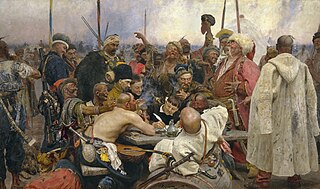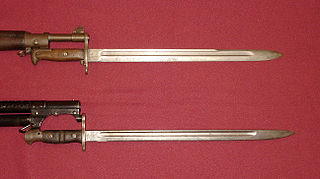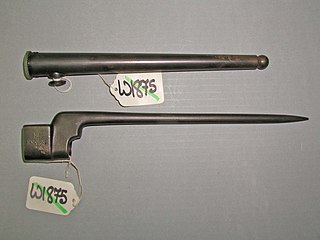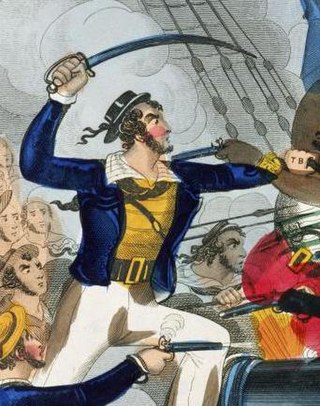
A bayonet is a knife, dagger, sword, or spike-shaped weapon designed to fit on the end of the muzzle of a rifle, carbine, musket or similar firearm, allowing it to be used as a spear-like weapon. From the early 17th to the early 20th century, it was a melee weapon used by infantry for offensive and/or defensive tactics. Today, it is considered an ancillary weapon or a weapon of last resort, although it is still used for ceremonial purposes.

The Lee–Enfield or Enfield is a bolt-action, magazine-fed repeating rifle that served as the main firearm of the military forces of the British Empire and Commonwealth during the first half of the 20th century, and was the British Army's standard rifle from its official adoption in 1895 until 1957. The WWI versions are often referred to as the SMLE, which is short for the common "Short, Magazine, Lee–Enfield" variant.

The Ross rifle is a straight-pull bolt action rifle chambered in .303 British that was produced in Canada from 1903 until 1918.
The Lanchester is a submachine gun manufactured by the Sterling Armaments Company between 1941 and 1945. It is a copy of the German MP28/II and was manufactured in two versions, Mk.1 and Mk.1*; the latter was a simplified version of the original Mk.1, with no fire selector and simplified sights. It was primarily used by the Royal Navy during the Second World War, and to a lesser extent by the Royal Air Force Regiment. It was given the general designation of Lanchester after George Lanchester, who was charged with producing the weapon at the Sterling Armaments Company.

The Webley Revolver was, in various designations, a standard issue service pistol for the armed forces of the United Kingdom, and countries of the British Empire and the Commonwealth of Nations, from 1887 to 1970.

The shashka or shasqua is a kind of sabre; a single-edged, single-handed, and guardless backsword. The comparatively subtle curve of a shashka blade puts the weapon midway between a typically curved sabre and a straight sword, effective for both cutting and thrusting.

The M1917 Enfield, the "American Enfield", formally named "United States Rifle, cal .30, Model of 1917" is an American modification and production of the .303-inch Pattern 1914 Enfield (P14) rifle, which was developed and manufactured during the period 1917–1918. Numerically, it was the main rifle used by the American Expeditionary Forces in Europe during World War I. The Danish Sirius Dog Sled Patrol on Greenland still use the M1917, which performs reliably in Arctic conditions, as their service weapon.

The M1917 bayonet was designed to be used with the US M1917 Enfield .30 caliber rifle, as well as with the seven different U.S. trench shotguns. The blade was 17 inches (43 cm) long. It will not fit the M1903 .30 caliber (Springfield) or the M1 .30 caliber (Garand) US service rifles as they have different bayonet ring (barrel) and attachment stud dimensions.
The Pattern 1913 Enfield (P'13) was an experimental rifle developed by the Royal Small Arms Factory for the British Army as a result of its combat experience in the Second Boer War from 1899 to 1902. The weapon was to serve as a replacement for the Short Magazine Lee–Enfield (SMLE). An advanced chamber design allowed for a high-velocity .276 Enfield rimless round, which was more powerful than the service-issued .303 British cartridge. Introduction of the P'13 was rendered impractical by the outbreak of the First World War.

The Rifle, .303 Pattern 1914 was a British service rifle of the First World War period, principally manufactured under contract by companies in the United States. It was a bolt-action weapon with an integral 5-round magazine. It served as a sniper rifle and as second-line and reserve issue, until declared obsolete in 1947. The Pattern 1914 Enfield was the successor to the Pattern 1913 Enfield experimental rifle and the predecessor of the U.S. Rifle M1917 Enfield.

The origins of the modern British military rifle are within its predecessor the Brown Bess musket. While a musket was largely inaccurate over 100 yards (91 m), due to a lack of rifling and a generous tolerance to allow for muzzle-loading, it was cheap to produce and could be loaded quickly. The use in volley or in mass firing by troops meant that rate of fire took precedence over accuracy.

The Model of 1905 bayonet was made for the U.S. M1903 Springfield rifle. This designation was changed to Model 1905 in 1917, and then to M1905 in 1925, when the army adopted the M designation nomenclature. The M1905 bayonet has a 16-inch (40.6 cm) steel blade and a 4-inch (10.16 cm) handle with wooden or plastic grips. The bayonet also fits the U.S. M1 Garand rifle. From 1943 to 1945, a shorter, 10-inch (25.4 cm), bladed version was produced with black or dark red molded plastic grips, and designated the M1 bayonet. A number of M1905 bayonets were recalled from service, their blades cut down, and reissued as M1 bayonets.
The Rifle 7.62mm 2A/2A1 is a 7.62×51mm NATO calibre bolt-action rifle adopted as a reserve arm by the Indian Armed Forces in 1963. The rifle is a variant of the Lee–Enfield rifle. The design of the rifle – initially the Rifle 7.62mm 2A – began at the Rifle Factory Ishapore of the Ordnance Factories Board in India, soon after the Sino-Indian War of 1962.

The Model 1840 noncommissioned officers' sword was adopted by the United States military in 1840. Based primarily on a sword used by the French Army, the model 1840 NCO proved somewhat heavy hilted and ill balanced. For over 70 years, it was widely used by the Army; today its usage is restricted to ceremonial occasions. The sword had a 31-inch blade, a cast brass hilt resembling the more expensive wire-wrapped leather grips, and a leather scabbard rather than the steel used by cavalry troopers and officers, although some makers, such as Emerson and Silver, issued a steel scabbard rather than leather to protect from wear. Leather scabbards were phased out beginning in 1868.

The Pattern 1796 heavy cavalry sword was the sword used by the British heavy cavalry, and King's German Legion Dragoons, through most of the period of the Revolutionary and Napoleonic Wars. It played an especially notable role, in the hands of British cavalrymen, at the battles of Salamanca and Waterloo. The pattern was adopted by Sweden and was used by some Portuguese cavalry.
The Lithgow Small Arms Factory, or Lithgow Arms, is an Australian small arms manufacturing factory located in the town of Lithgow, New South Wales. It was created by the Australian Government in 1912 to ease reliance on the British for the supply of defence materials.

The No. 4 Bayonet was the standard bayonet for all Lee Enfield No 4 rifles.

The No. 5 Bayonet was the bayonet used with the No 5 Lee-Enfield which is nicknamed "Jungle carbine ". The bayonet was a blade which marked a return of the British Army to using blade type bayonets like the Pattern 1907 bayonet instead of socket bayonets such as the No. 4 Bayonets used on the No. 4 Lee-Enfield.

Ratings of the Royal Navy have used cutlasses, short, wide bladed swords, since the early 18th century. These were originally of non-uniform design but the 1804 Pattern, the first Navy-issue standard cutlass, was introduced at the start of the 19th century. This was a bluntish weapon that was perhaps intended for cutting away canvas and ropes rather than as a thrusting combat weapon. The 1845 Pattern cutlass introduced a bowl-style hand guard which provided greater protection, with a longer and more curved blade. Its sharper point made it more useful for thrusting attacks, which were now emphasised in the drill manual. The 1845 Pattern was modified several times including shortening and straightening the blades, which weakened them. The 1889 Pattern had a straight, spear-pointed blade with a hilt that curved outwards to catch and redirect an opponent's sword point. The 1900 Pattern, the last navy-issue cutlass, was similar to its predecessor with the introduction of a fuller and a hilt insert that cushioned the user's little finger. The cutlass was withdrawn from service in 1936 but remains in use for ceremonial purposes. It is thought that it was last used in combat in 1900 during the Boxer Rebellion.

















